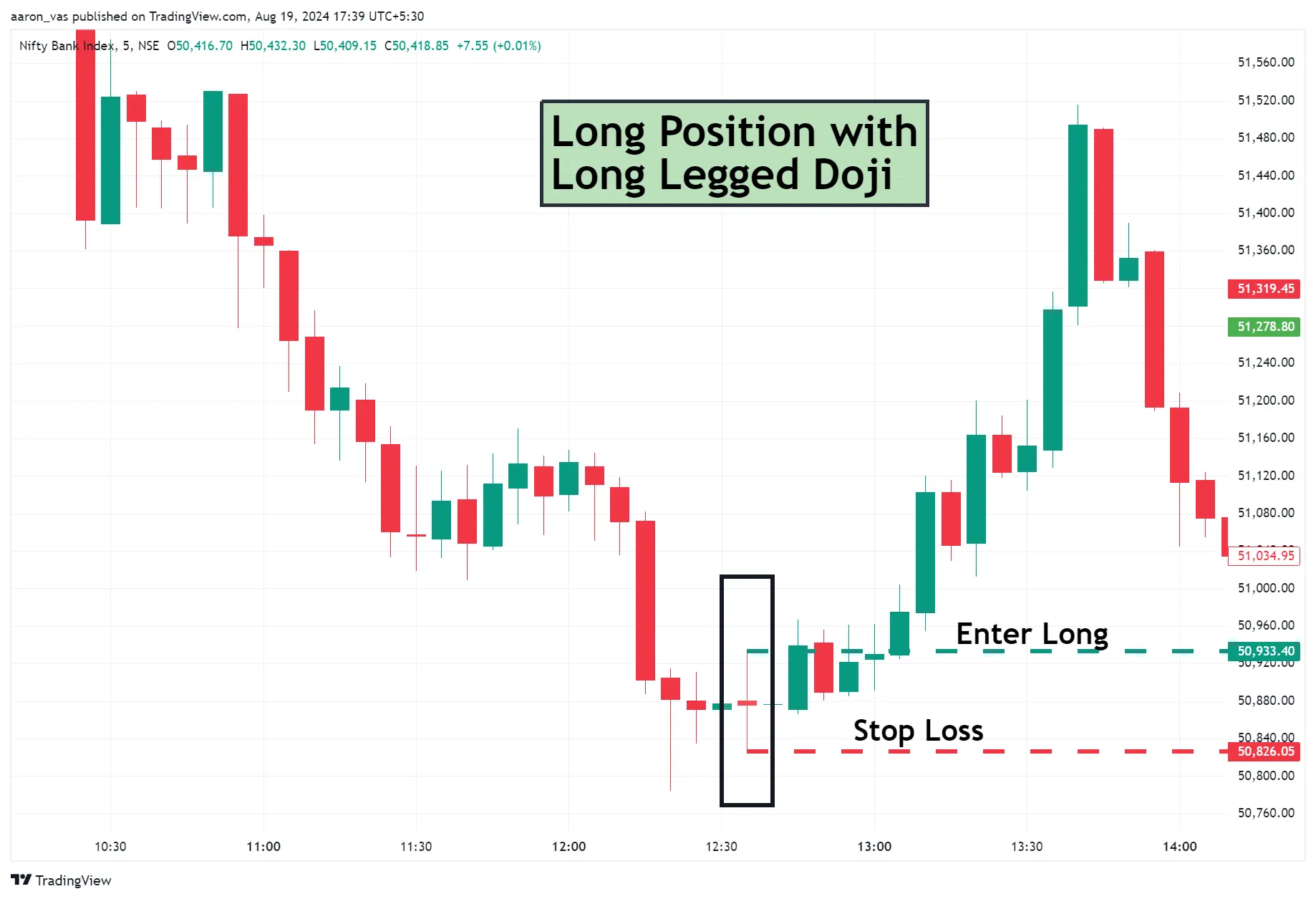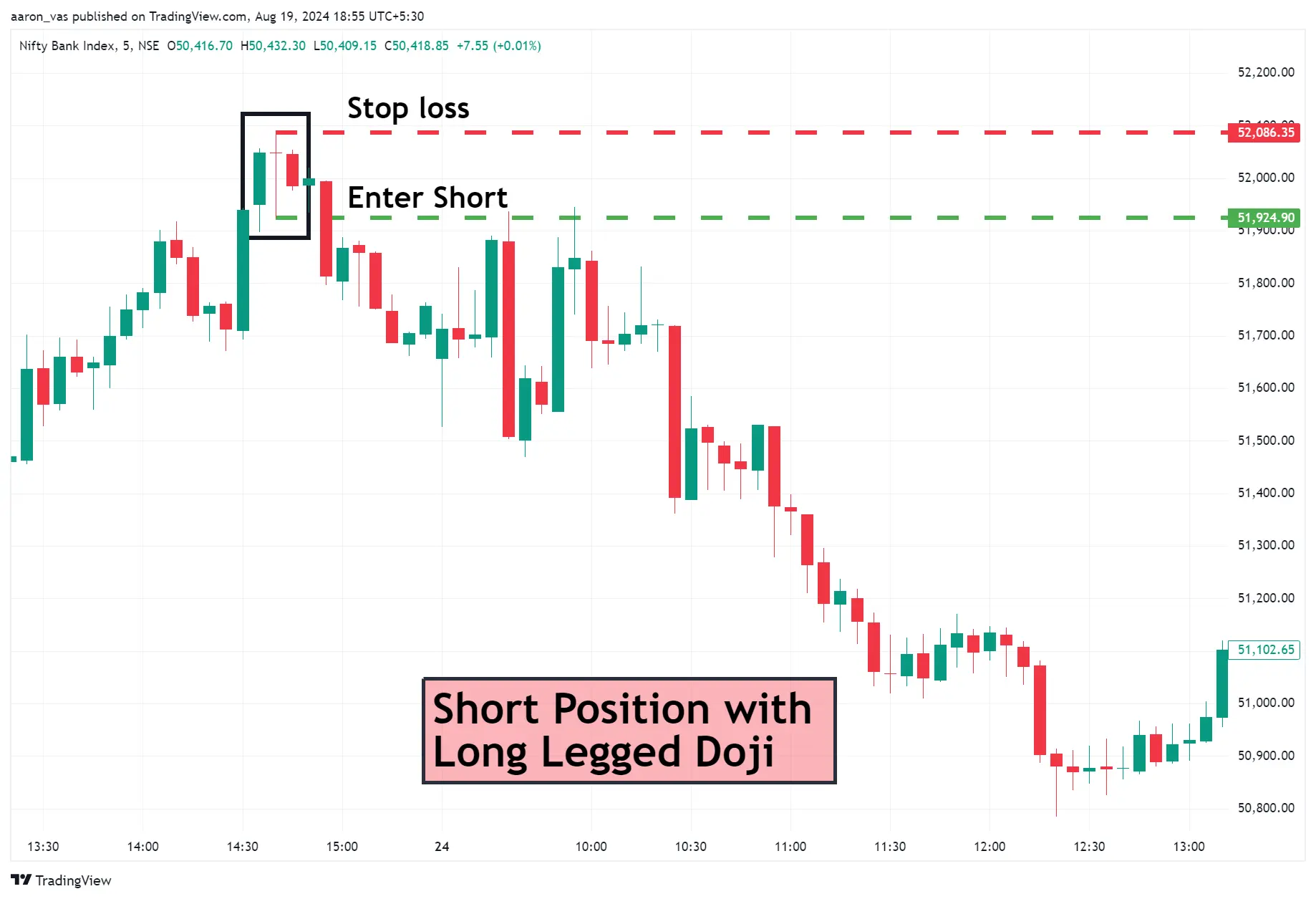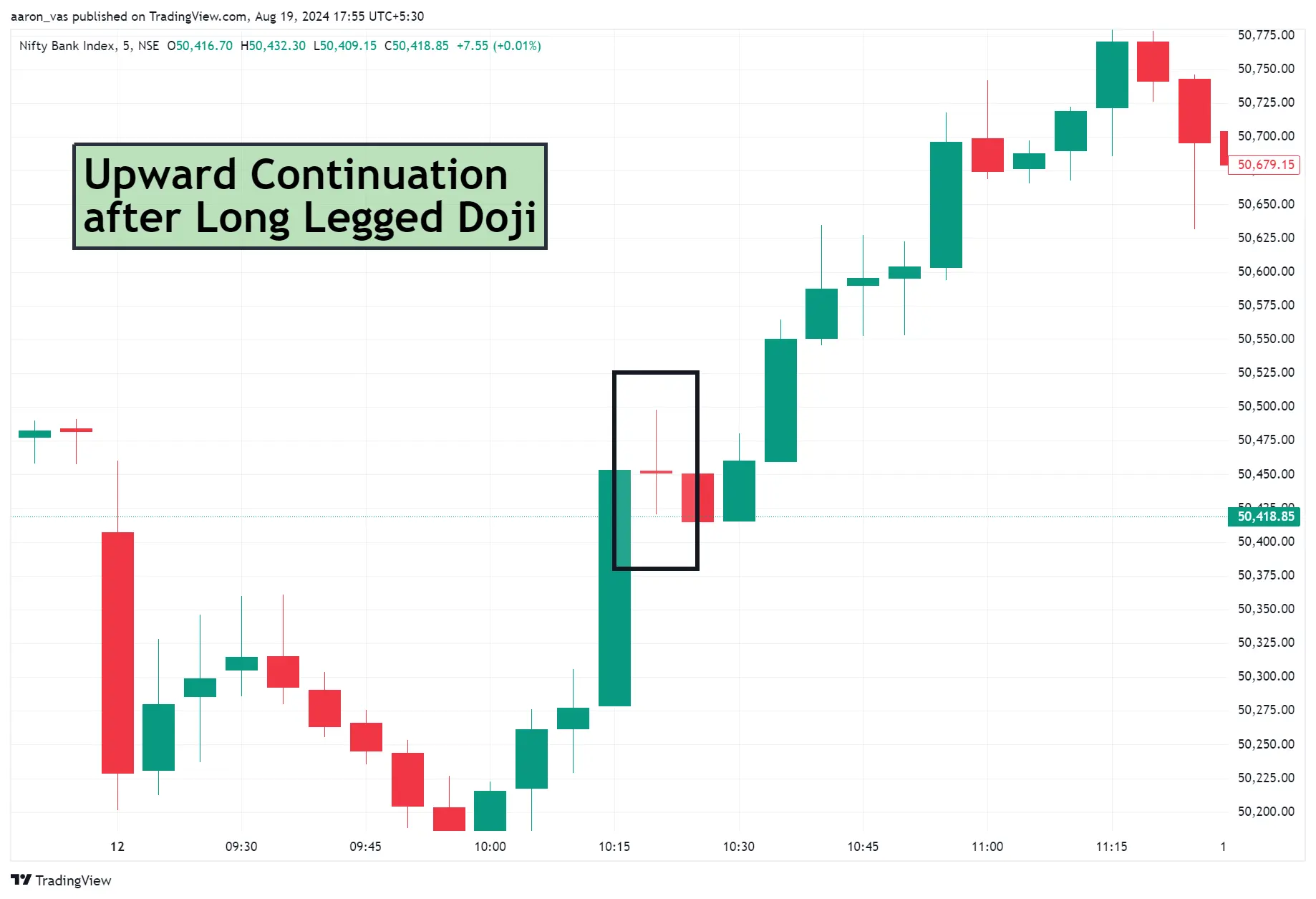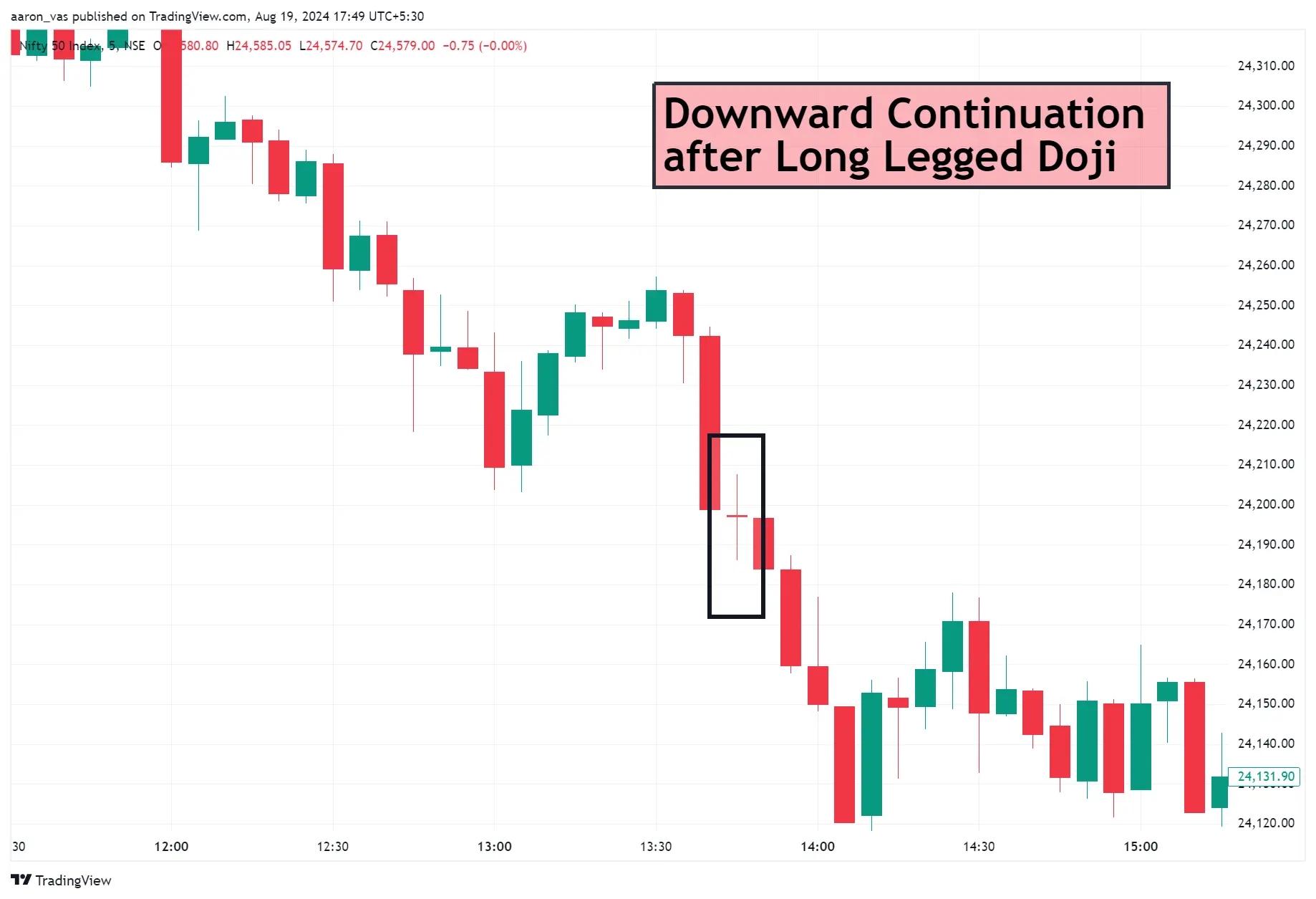Long Legged Doji Candlestick - Meaning, Examples, Strategy


00:00 / 00:00
The discovery of various candlestick patterns over a century ago has been instrumental in enabling traders to identify both bullish and bearish signals in the market. However, there are some neutral candlestick patterns that do not indicate either bullish or bearish trends in stocks
Long Legged Doji candlestick is one such pattern. In this article, we will understand the Long Legged Doji candlestick pattern, its meaning, what it indicates, and how to trade it effectively.
What is a Long Legged Doji Pattern
A long legged doji is a neutral candlestick pattern that indicates an indecision between the buyers and sellers in the market. This pattern suggests that both the buyers and the sellers are trying to push the price in their direction but neither side can gain control by the end of the session. Based on the overall context of the market, the long legged doji candlestick can be used for a bullish as well as a bearish reversal.
What Does a Long Legged Doji Indicate
The Long Legged Doji candlestick comprises of a non-existent body positioned between a large upper and lower wick as marked in the below chart as well. In a long legged doji, the opening price and the closing price of the security will almost be on the same level due to which the body is non-existent.
In a long legged doji formation, a large number of buyers are trying to push the price higher but the sellers are rejecting the upward price movement. Similarly, a large number of the sellers also try pushing the price lower but the downward movement gets rejected by the buyers. This battle between the buyers and the sellers to gain the upper hand causes the huge upper and lower wick of the long legged doji.
However, at the end of the session, due to the equal buying and selling pressure in the security, the price closes near the opening price which results in the small non-existent body of the long legged doji candlestick. This pattern suggests an indecision between the buyers and the sellers in the security during the session.
How to Spot a Long Legged Doji Candlestick
The following are the key points to remember to identify the Long Legged Doji Candlestick pattern:
Location: A long legged doji can appear during any trend. The pattern's appearance during a downtrend can suggest a potential bullish reversal and its appearance near an uptrend can suggest a potential bearish reversal.
Shape: The long legged doji should have a non-existent body and large upper and lower wicks as marked in the chart given below.
Color: As the body of the long legged doji is practically non-existent, the color of the pattern is irrelevant. It can either be red long legged doji or a green long legged doji.
How to Trade the Long Legged Doji Pattern
As discussed above, a Long Legged Doji Pattern indicates neutrality in the market and can be used for both bullish reversal as well as bearish reversal in the security. Let us now discuss the ways one can enter long and short positions using long legged doji with examples.
Long Legged Doji Example -Trading Long Position

Entry: If a Long Legged Doji pattern appears after the formation of a downtrend, one can consider entering a long position in the security.
When the price of the security crosses above the high of the Long Legged Doji, it suggests that the buyers were able to overcome the selling pressure in the market. Thus you can enter a long position above the high of the Long Legged Doji as shown in the image.
Stop Loss: As the low of the Long Legged Doji indicates the price where the sellers were rejected, it is considered the ideal point of stop loss in security.
Profit Target: As the Long Legged Doji is just a single candlestick pattern, its profit target can be based on the immediate resistance level, trailing stop loss method, or risk-to-reward ratio.
Long Legged Doji Example - Trading Short Position

Entry: If a Long Legged Doji pattern appears after the formation of an uptrend, one can consider entering a short position in the security.
When the price of the security crosses below the low of the Long Legged Doji, it suggests that the sellers were able to overcome the buying pressure in the market. Thus you can enter a short position below the low of the Long Legged Doji pattern as shown in the image.
Stop Loss: As the high of the Long Legged Doji pattern indicates the price where the buyers were rejected, it is considered the ideal point of stop loss in security.
Profit Target: As the Long Legged Doji is just a single candlestick pattern, its profit target can be based on the immediate support level, trailing stop loss method, or risk-to-reward ratio.
Continuation Patterns with the Long Legged Doji
While a Long Legged Doji pattern after an uptrend or downtrend can be used in reversal trading, keep in mind that reversals will only occur if the trend's overall outlook is weak.
If the current trend is strong, the security will most likely continue in the previous direction following the appearance of the Long Legged Doji. Thus, it is always recommended to employ the Long Legged Doji pattern in conjunction with other technical tools to obtain better trade signals.
Following are examples where the prior trend has continued after the appearance of the Long legged doji pattern:


Limitations of Long Legged Doji
Lack of Directional Bias: As the Long Legged Doji pattern suggests equal pressure from the buyers and the sellers, it does not give you a clear signal about the direction of the security.
Requires additional confirmation: As the Long Legged Doji is a single candlestick pattern, validation from the next candle is required for any potential signals. Learn how to predict next candlestick to improve your chances.
No Profit Targets: As the Long Legged Doji is a single candlestick pattern, it does not provide levels where traders would need to book profits in a trade.
Doji and Long Legged Doji - Key Differences
Both the Doji pattern and Long Legged Doji indicate indecision between the buyers and sellers in the market and the appearance of both of these patterns at the end of any trend signals a potential reversal in security. However, they have the following differences:
Features | Doji | Long Legged Doji |
Appearance | Small body with very short upper and lower shadows. | Small body with very long upper and lower shadows. |
Volatility | Low volatility during the session | High volatility during the session |
Market Sentiment | Neutral, suggesting a potential reversal or continuation depending on the preceding trend. | Extreme indecision, the market may be at a tipping point or ready for a strong move. |
Conclusion
We have reached the end of the article on the Long Legged Doji Pattern. Before we wind up, it is important to note that the Long Legged Doji is a neutral pattern and does not always guarantee a bullish or a bearish reversal. Thus, you should always use the Long Legged Doji candlestick pattern along with the combination of other technical indicators.
You can utilize a range of technical indicators and take advantage of features such as trailing stop loss and margin trading on our Rupeezy trading app. Open Demat account today and earn a 20% commission on every trade made by referring your friends and family.
The content on this blog is for educational purposes only and should not be considered investment advice. While we strive for accuracy, some information may contain errors or delays in updates.
Mentions of stocks or investment products are solely for informational purposes and do not constitute recommendations. Investors should conduct their own research before making any decisions.
Investing in financial markets are subject to market risks, and past performance does not guarantee future results. It is advisable to consult a qualified financial professional, review official documents, and verify information independently before making investment decisions.
Open Rupeezy account now. It is free and 100% secure.
Start Stock InvestmentAll Category









